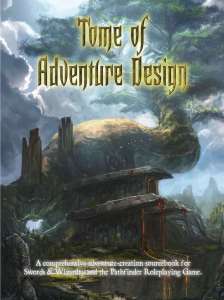Monte Cook’s thirty-plus years as a game designer include credits co-designing third-edition Dungeons & Dragons and his science-fantasy roleplaying game Numenera, which mirrors some broad patterns of D&D. Numenera includes characters that resemble fighters, rogues, and spellcasters who gather to explore dangerous places. Players even roll d20s and aim to reach target numbers that rate a task’s difficulty. Make no mistake though, Numenera features innovations. Monte writes, “I think I have some fresh variations on some concepts that are in games now, and some wholly new ideas as well.”
For example, Monte noticed that players have more fun rolling to attack than watching a dungeon master make a foe’s saving throw. Rolling gives us an emotional sense of involvement. So in Numenera, the players always roll the dice. When players attack, they roll to hit; when monsters attack, the players roll to defend.

Letting players always roll has the side effect of eliminating the GM’s ability to fudge rolls. “If the dice don’t mean anything, then everything is predetermined, and it’s no longer a game by any definition—just a story being told,” Monte writes. “So the dice need to matter. But that means that sometimes a PC will fail when they would succeed if it were a story, and vice versa. That’s not a flaw; it’s a feature. It’s what makes roleplaying games so exciting.” Dice make roleplaying games unpredictable and dynamic. Numenera embraces that. (You may like how fudging rolls gives a GM power fit the game into a story, but Numenera gives GMs and players other tools to help shape a thrilling narrative.)
Numenera highlights the fun and drama of rolling dice in other ways. One has influenced how I run D&D and improved my games.
The rules of D&D encourage rolling first, and then adding bonuses and penalties to learn whether the roll means success or failure. The delay of calculating after the roll often robs the roll of potential drama.
Numenera puts the calculations before the roll by making things like skills and circumstances adjust the target difficulty. By the time the players throw the dice, they know exactly the number they need. Monte explains that calculating before the roll “makes task resolution–and in particular combat–move much, much more quickly if you’re not waiting for people to add together numbers (or to ensure they have all their various miscellaneous modifiers accounted for).” Even better, calculating first gives the roll an immediate significance that everyone playing understands.
Of course D&D players and DMs can calculate the target number needed for success before rolling too. Just subtract all the bonuses from the DC. As a DM, I often announce these target numbers before open rolls to wring maximum drama from a roll of the dice. As a DM under the influence of Numenera, I find myself making such announcements before nearly every roll. I’ve always rolled in the open, but when players know what the numbers mean, they pay attention and they react to the numbers.
Calculating a target number in advance hardly takes extra effort. Sure, some very low or high rolls could have skipped the math entirely. But pre-calculating often makes up for the occasional unnecessary effort in volume. If I roll a save for the 7 ghouls in a fireball and I know they need a 13 to succeed, I can toss 7 d20s and spot all the successes in an instant. If I throw the dice with just DC 15 and +2 in my head, then making sense of 7 numbers on the dice and the 2 numbers in my head takes much longer.
The most exciting moments in games like Numenera and D&D often come from die rolls. When we throw the dice, game masters and players alike surrender control to chance. For maximum drama, don’t make players wait for calculation of the results. Tell everyone the number to look for on the die.







 Every D&D game has rolls important enough to grab everyone’s attention. Does the dragon’s breath weapon recharge? Did the inspirational speech win an ally? A die roll can spell the difference between victory or defeat, and sometimes between life and death. As a DM, you can spotlight these moments to heighten the drama and excitement.
Every D&D game has rolls important enough to grab everyone’s attention. Does the dragon’s breath weapon recharge? Did the inspirational speech win an ally? A die roll can spell the difference between victory or defeat, and sometimes between life and death. As a DM, you can spotlight these moments to heighten the drama and excitement.
